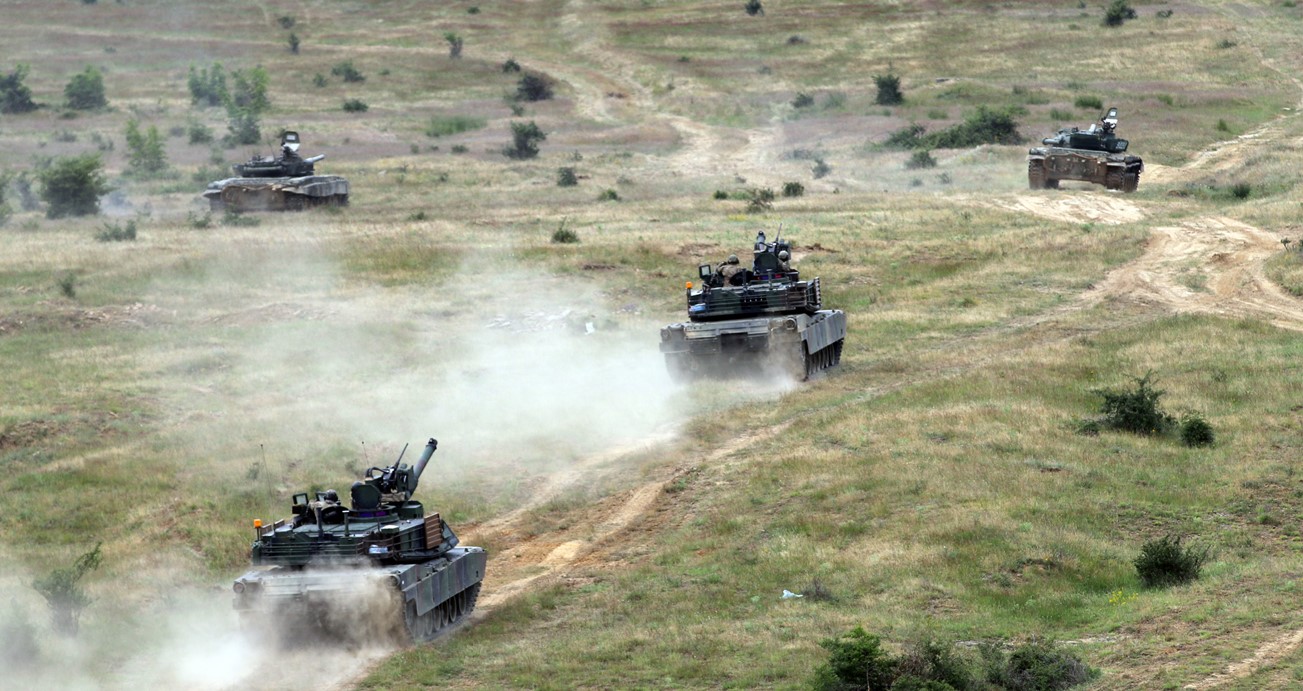
US Army M1 Abrams tanks train inside Bulgaria. (US Army)
This report was updated at 3:15pm ET with new information from Army acquisition chief Douglas Bush.
WASHINGTON — Thirty-one American M1 Abrams main battle tanks will eventually make their way to Kyiv to help in the battle against Russia, US President Joe Biden said today, just hours after Germany said it, too, would free German-made Leopards for the fight. However, the Pentagon is still grappling with which M1 Abrams variant to deliver and on what timeframe.
Biden made the official declaration midday local time, announcing that the 31 M1 Abrams, one Ukrainian battalion-worth, will be heading to the Eastern European country to help “defend [and] protect Ukrainian land.”
“Today’s announcement builds on the hard work and commitment from countries around the world… to help Ukraine defend sovereignty and territorial integrity,” Biden said, flanked by Secretary of State Lloyd Austin and Secretary of State Antony Blinken. “That’s what this is about…[this] is not an offensive threat to Russia.”
The point of sending the tanks, like all the other security aid that’s gone to Kyiv, was to push Russian soldiers back to Russian territory, Biden said. If Russian troops returned home, the war would be over “tomorrow.”
RELATED: What is a ‘main battle tank,’ and how will Ukraine use them?
Just before Biden’s speech, several administration officials previewed the announcement to reporters. Those officials declined to specify which Abrams tank variant will be sent to Ukraine but said the US will not pull these vehicles from units or existing stockpiles and instead use the Ukraine Security Assistance Initiative. A DoD factsheet said they’d be part of a $400 million USAI package.
“While the deliveries will take some time, because this is a procurement, the United States will begin now to establish a comprehensive training program for their use,” one administration official said. “These tanks are complex systems that require a significant amount of training and maintenance, so [the Department of Defense] is currently working through the mechanisms to deliver the fuel and equipment Ukraine will need to operate and to maintain the Abrams.”
That official declined to detail when the Abrams tanks will arrive inside the country but said it will take “months as opposed to weeks.” Once there they will help Ukraine with combined arms maneuver operations to “to defend and reclaim their territory,” the official said.
Part of the reason questions about the Abrams variant and delivery timeline went unanswered is because the administration hasn’t decided on a firm path ahead, according to Assistant Secretary of the US Army for Acquisition, Logistics, and Technology Douglas Bush. Speaking to reporters after the announcement, Bush said the Army is creating a laundry list of options for Pentagon officials to consider before deciding which way to go.
“There are multiple courses of action and it’s not just the tanks,” he added. “We have to be able to [deliver] tanks, support equipment, the training, the ammunition, the fuel… It’s really a bigger picture.”
Senior Pentagon leaders will likely wade through a host of complex issues including questions over sensitive technology and geopolitical implications of their decisions. As just one example, the M1A2 System Enhancement Program version 3 (SEPv3) Abrams tank can integrate with Israeli manufacturer Rafael’s Trophy active protection system to shoot down incoming threats like anti-tank guided missiles and rocket-propelled grenades. However, Israel’s government does not want to supply Ukraine with its weapons.
Today’s announcement is a stark departure from the administration’s prior public reservations about sending the Abrams, having argued it is simply not the right tank for Ukraine, due in part, to a myriad of logistics hurdles including with fuel, maintenance and the tank’s sheer weights and size on European roads and bridges. Even just Tuesday Pentagon Press Secretary Pat Ryder reasserted that those tanks are challenging to maintain and that remains “true yesterday. It’s true today. It’ll be true in the future.”
The senior administration official did not detail a comprehensive plan to overcome those challenges but reasserted that the lag time between now and the delivery dates will provide the Pentagon with time to sort through some of those issues, including fuel, while also properly training Ukrainians how to operate and maintain that battalion of M1 Abrams tanks.
RELATED: Zelenskyy praises US plan to include ‘a’ Patriot battery in $1.9B weapons package
As for the about face, senior administration officials did not detail what changed their calculus over the past several days, but noted that continued talks with NATO allies, including Germany, have played a factor, especially at a time of concern over just what weapons may provoke Russian ire.
“This really was an iterative conversation that we have been having with the Germans,” the senior administration official said. “We’ll refer to the German government for them to speak on the timing and nature of their own decision, but certainly we have closely coordinated our security assistance with allies and partners throughout the conflict, including Germany.”
Additionally, the US is providing Ukraine with eight M88 Recovery Vehicles in case the Abrams tanks break down or get stuck in the mud and need to be towed for repairs, perhaps a sign of the logistical, practical challenges to be overcome.
Move over FARA: General Atomics pitching new Gray Eagle version for armed scout mission
General Atomics will also showcase its Mojave demonstrator for the first time during the Army Aviation Association of America conference in Denver, a company spokesman said.


























